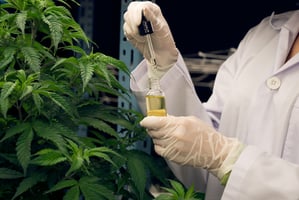The stability of cannabinoid products is a critical factor for manufacturers aiming to deliver high-quality, safe, and effective products. Cannabinoids, particularly tetrahydrocannabinol (THC) and...
Understanding Cannabinoid Degradation Pathways
Cannabinoids

Dec 13, 2024 | Published by Broughton
Cannabinoids
The stability of cannabinoid products is a critical factor for manufacturers aiming to deliver high-quality, safe, and effective products. Cannabinoids, particularly tetrahydrocannabinol (THC) and cannabidiol (CBD), are naturally occurring compounds in Cannabis sativa known for their therapeutic potential. However, these compounds are inherently unstable and prone to degradation under various environmental conditions, which can significantly impact product quality, efficacy, and safety.
What Causes Cannabinoid Degradation?
Cannabinoids degrade through several pathways influenced by environmental factors:
- Light Exposure: Ultraviolet (UV) light can accelerate the breakdown of cannabinoids. For example, THC degrades into cannabinol (CBN), a less psychoactive compound, when exposed to light.
- Heat: Elevated temperatures can cause cannabinoids to decarboxylate and degrade further, particularly during storage or in high-heat delivery systems like vaping.
- Oxidation: Oxygen exposure triggers oxidative reactions that alter the chemical structure of cannabinoids, resulting in decreased potency and potential formation of unwanted by-products.
- pH Variations: Acidic or basic environments can catalyse degradation reactions, particularly for CBD, which can convert to THC under certain conditions.
The Impacts of Degradation
Degradation affects cannabinoid products in several ways:
- Reduced Efficacy: The active compounds responsible for therapeutic benefits may degrade, reducing the product’s effectiveness.
- Toxicological Risks: Breakdown products may have unknown or harmful effects on consumers. For example, the formation of cannabinoid quinones can pose safety concerns.
- Legal and Regulatory Issues: Degradation can lead to the formation of controlled substances like THC from CBD, creating compliance challenges for manufacturers.
Strategies to Mitigate Degradation
Understanding and mitigating degradation pathways is essential for maintaining product integrity. Manufacturers can adopt several strategies to protect cannabinoids:
- Optimised Packaging: Use materials that block light and have low oxygen permeability to reduce exposure to degradation triggers.
- Controlled Storage Conditions: Maintain appropriate temperature and humidity levels to minimise thermal and oxidative stress.
- Stability-Indicating Methods: Implement advanced analytical techniques to monitor degradation products and ensure regulatory compliance.
Conclusion
Cannabinoid degradation is a complex process influenced by various environmental factors and product formulations. For manufacturers, understanding these pathways is vital to delivering products that meet safety, efficacy, and regulatory standards. Through robust stability studies and proactive measures, the risks of cannabinoid degradation can be effectively managed, ensuring product quality and consumer trust.
If you’d like expert support in assessing and mitigating cannabinoid degradation, Broughton’s team of specialists can provide comprehensive stability testing and consultancy services.
Download our whitepaper to learn more about safeguarding your cannabinoid products.


